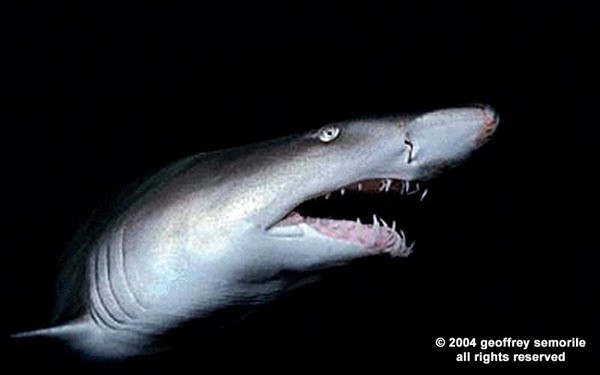- geoffrey semorile
- View Portfolio
- Image 127 of 158
- Added 02 Jan 2004
- 335 Views
- Share This Image On...

RAGGED TOOTH SHARK - SOUTH AFRICA - ALI WAL SHOALS - JUST SOUTH OF DURBAN ON THE EAST COAST - INDIAN OCEAN SHOOTING SNOW BALLS IN A COAL MINE Some information you might find of interest regarding the creation of this image. The coloration of many fish including sharks is often darker on the top of the fish and lighter on the underside. This is thought to be a form of camouflage to disguise them from predators that might be above them. During the day it makes them blend into the darker sea bottom or open ocean as light from the surface is absorbed through the process having to travel through water. The deeper you go the darker it gets. As you can see in this image the shark is almost white against a much darker background, creating the snowball in a coalmine lighting situation. For these kinds of shots you need much less light than you think to avoid over exposing the lighter and more reflective underside of the fish and losing all the skin detail. What appears, as a black background is Open Ocean that will absorb all the light from your strobes making it appear black if shooting at smaller lens apertures. Giving the impression to the viewer the shot was taken at night. This shot was actually taken at midday at a depth of sixty feet looking up towards the surface. It was an overcast day with considerable surface chop which cuts way down on the amount of sunlight that is able to penetrate to this depth. If I had used a larger aperture and less strobe light it would have made the background lighter utilizing available light from the surface. What I wanted to convey in this shot was the stark contrast of the shark in the foreground and the depth of his environment, Deep Ocean. The black background more effectively illustrates this impression and with greater drama. Sharks are generally very shy and reclusive usually disappearing into the depths at the arrival of a diver making them one of the more difficult underwater subjects to shoot. Getting close too them requires a great deal of patience and time. These opportunities are rare, few and far between. I have spent countless hours underwater in search of these fish only to see nothing but tails quickly disappear in the distant depths. For the most part they inhabit deeper water with some exceptions to that rule. So the time you can spend on this activity at those depths is limited by air supply and decompression restrictions. I prefer to shoot sharks up close and from below looking up as it gives them a more dominant posture and prominence in the image. The less water you have between the lens and subject the more effect your strobes will have on your ability to light your subject. A great photographer once said, if your pictures are not good enough, you are not close enough to your subject . Multiply that times fifty when applied to underwater photography. Light is absorbed at a tremendous rate over a very short distance underwater. Light falls off in at a square root factor, water being twenty times thicker than air. If your strobe light has to travel through water farther than five or six feet the water absorbs all its effect on your subject. For this reason you must use very wide lenses for big subjects and get very close. Water has other effects on light, both diffusion and distortion. If the subject is too far from the lens it appears diffused, fuzzy and not sharply defined. Material in the water will also add to the degradation of light over a given distance. Aiming your lights properly is critical to a successful shot of this kind. If you hit the water column between your lens and subject you will light material in the water and your image will look like it is snowing. If you throw to much light into the background water you will get much the same effect so narrow angle strobes are better suited to this type of photography, allowing you to place the light only on your subject where you need it. geoff